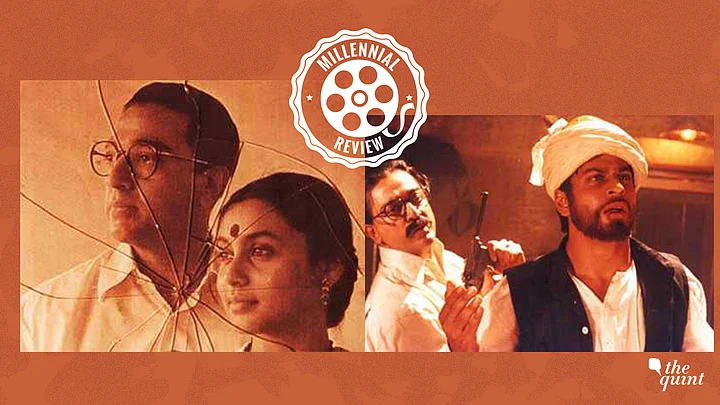Too busy to read? Listen to this instead:
Doused in communal violence and partition politics, Kamal Haasan’s period drama film Hey Ram (released in 2000) would probably never see the light of the day if it were to be released in 2019. In an age where the word ‘intolerance’ itself is a touchy subject and a couple of tweets are enough to make headlines, there’s unfortunately no room for alternative, in-depth narratives. Especially not one that seeks to revisit and question one of India’s most traumatic incidents — the assassination of Mahatma Gandhi at the hands of Nathuram Godse.
Directed by and starring actor-turned-politician Kamal Haasan, Hey Ram is the story of Saket Ram (Kamal Haasan) — a man living the cocooned life of an elite Indian during the British Raj, and his descent into hate politics and violence in the aftermath of the Partition. Initially, Haasan’s character does come off as an idealist, but our anti-hero is far from it.
Hey Ram’s three-and-a-half hour long journey begins with a bedridden Saket Ram, as his grandson, who is also tending to Saket’s sickness, decides to dive into a story from Saket’s life in pre-Independence India.
After a brief introduction of Saket Ram’s Pathan colleague Amjad (Shah Rukh Khan) and Sindhi friend Lalwani (Saurabh Shukla), we’re transported to 16 August, 1947 Calcutta where Saket is visiting his wife Aparna (Rani Mukerji). Eventually, Saket finds himself stuck in the middle of the ghastly communal rioting that takes over the city (the Great Calcutta Killings). Saket has to watch his beloved Aparna be raped and killed by a few Muslims as the Calcutta burns.
In one of the most gruesome portrayals of Hindu-Muslim violence that enveloped the country around the time of Partition, we watch a helpless Saket lash out as the city and people around him burn to death. Even as he kills, his actions haunt him.
Saket’s quest for revenge is born purely out of impulse. And just like a severed India is forced to embrace its new reality post 1947, Saket too has no choice but to move on in life with the wounds of his past holding him down every step of the way.
What particularly struck me about the Hey Ram’s portrayal of Calcutta riots was that the trauma is as much the audience’s as it is Saket’s. While watching Saket struggle as his wife gets raped in the room next to him, we start to share his pain. However, when he’s later confronted with a pleading “Altaf Tailor” (one of the men responsible for Aparna’s death), that same empathy suddenly becomes Altaf’s as he’s shot to death by a merciless Saket. It is also during these riots that Kamal Haasan’s Saket stumbles across a Hindu militant Sriram Abhayankar (Atul Kulkarni).
Now, in a so-called free India, a defeated Saket marries a woman named Mythili (Vasundhara Das) in Madras. Dripping in the memories of bloody violence and a desperation to hold someone responsible for what happened to Aparna, Saket finds his way back to an old acquaintance – Sriram Abhayankar. Soon, in the company of Sriram and a Maharaja (Vikram Gokhale), Saket is inducted into a Gandhi-hating group of sorts and given the responsibility of killing Gandhi.
Despite being a multilingual film, with a majority of Tamil dialogues, Hey Ram’s distinct filmography retains an old-school Bollywood-esque feel. Simply put, it is a visual treat
But there’s no doubt about the fact that it’s Hey Ram’s script that makes it worth a revisit even today. For a film that was made nearly two decades ago, Hey Ram still manages to accurately capture the political climate of 21st century India. Moreover, to delve into the psyche of a character that resonates so closely with one of Indian history’s most controversial personalities is in itself brave. And to be able to do that with so much objectivity and nuance too is a work of genius.
For all those holding their breaths, Saket does not assassinate Gandhi; Nathuram Godse does. Despite being two different characters, Saket is, in a way, Nathuram Godse’s alter ego.
In the final segment of Hey Ram (which lasts for one whole hour), we watch as the film’s seriousness begins to dissolve and give way to mawkishly sentimental dialogues and a rather ironic plot twist. A police scare forces Saket to get rid of his Gandhi-killing weapon. While in search for his gun, Saket meets his old friend Amjad (Shah Rukh Khan), who is now a Gandhian, in a Muslim-dominated area.
As fate would have it, a Hindu mob attacks the area and Saket, conflicted yet again, ends up fighting against the Hindus to protect Amjad – and by extension, all the Muslims in the area.
For a film that is loaded with symbolism, it’s no surprise that Saket Ram’s life comes a full circle. Now, back to the present, we watch Saket Ram take his last breath in an underground shelter, as the riots above him continue to engulf more innocent lives like his.
Recently, while addressing a crowd of people in Tamil Nadu, Kamal Haasan referred to Nathuram Godse by declaring that free India’s first extremist was a Hindu.
That one statement was enough for BJP’s Pragya Thakur to retaliate by calling Godse a “patriot” instead.
In many ways it seems like 2019 is no different from the sectarian sensibilities and vulnerability that dominated the India in Kamal Haasan’s Hey Ram. Even today, people are quick to react and get easily triggered, especially by words like ‘Hindu’ and ‘Muslim’. But unlike Saket’s free India, we no longer have the liberty to blame our shortcomings on the trauma gifted to us by the British.
